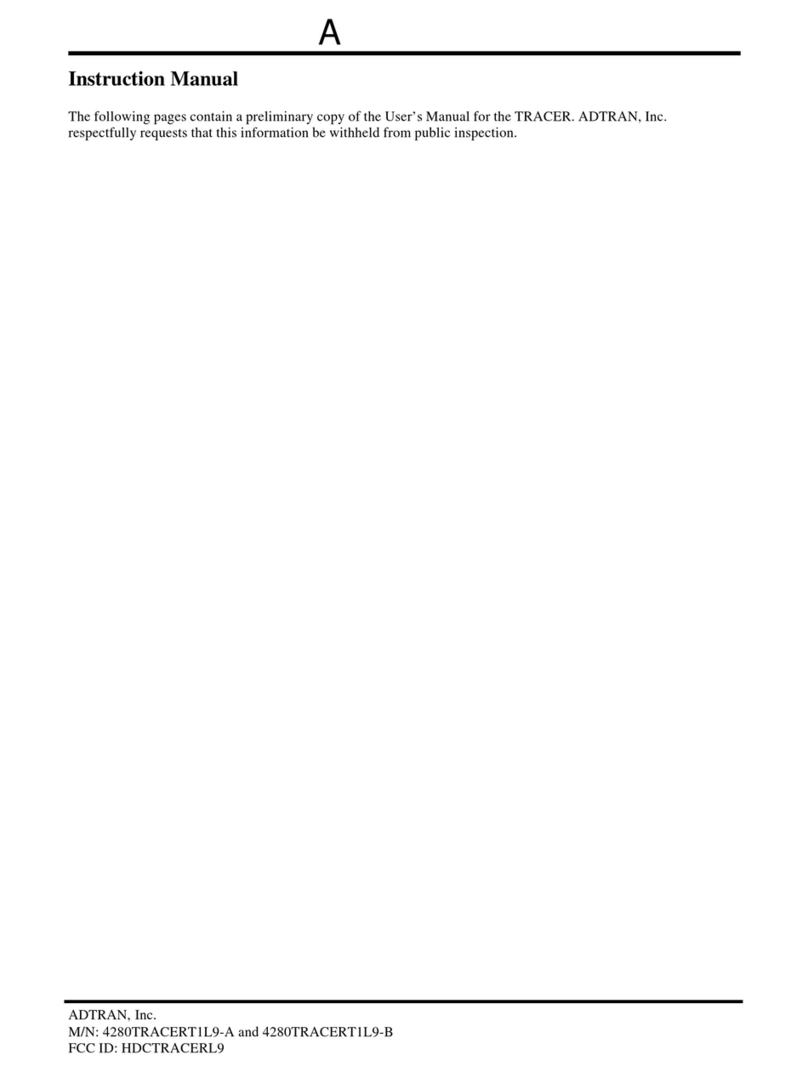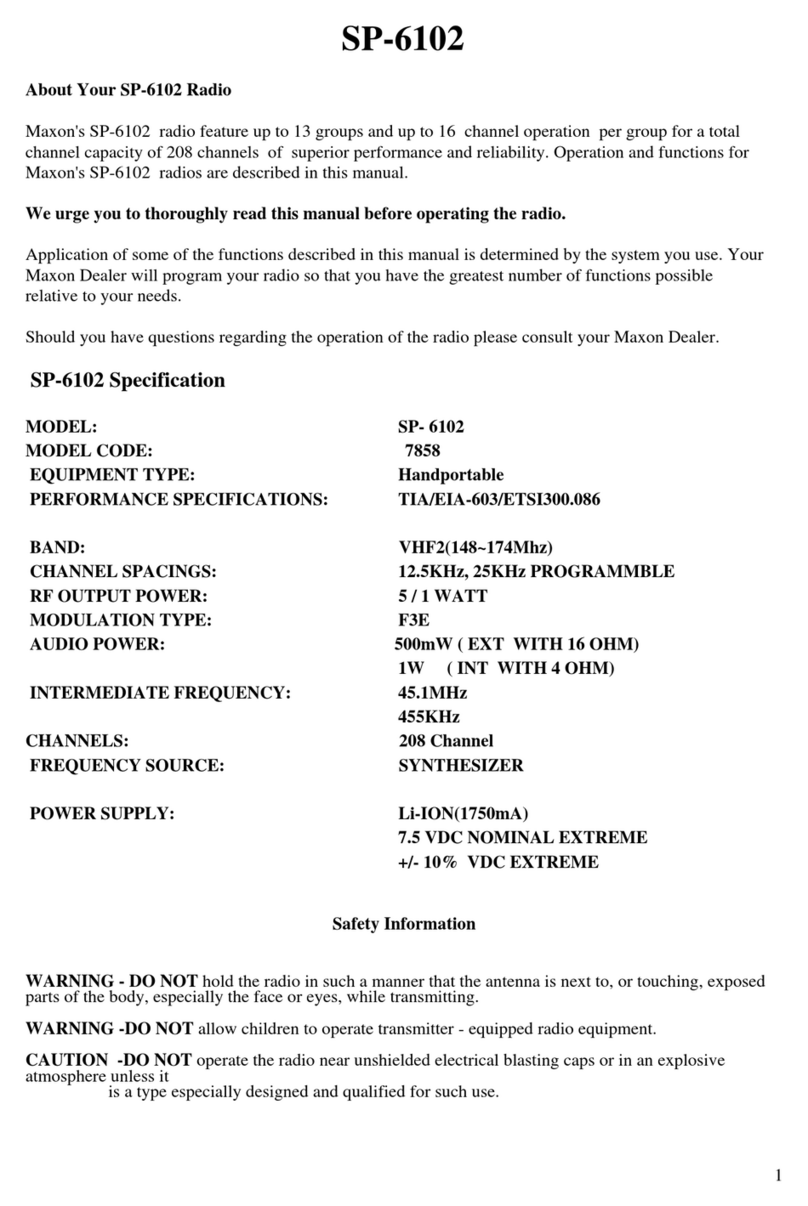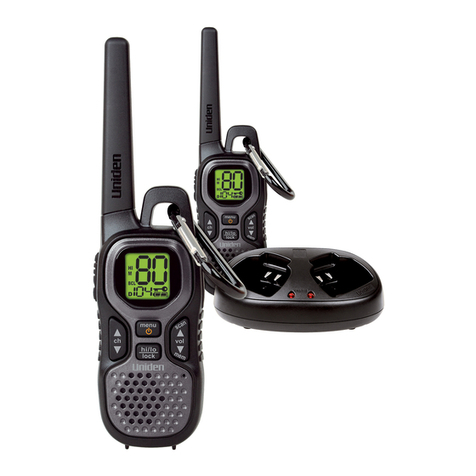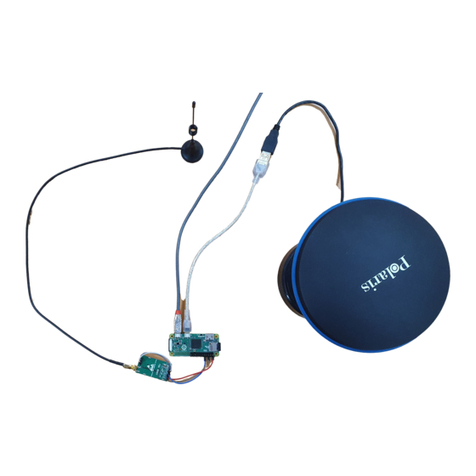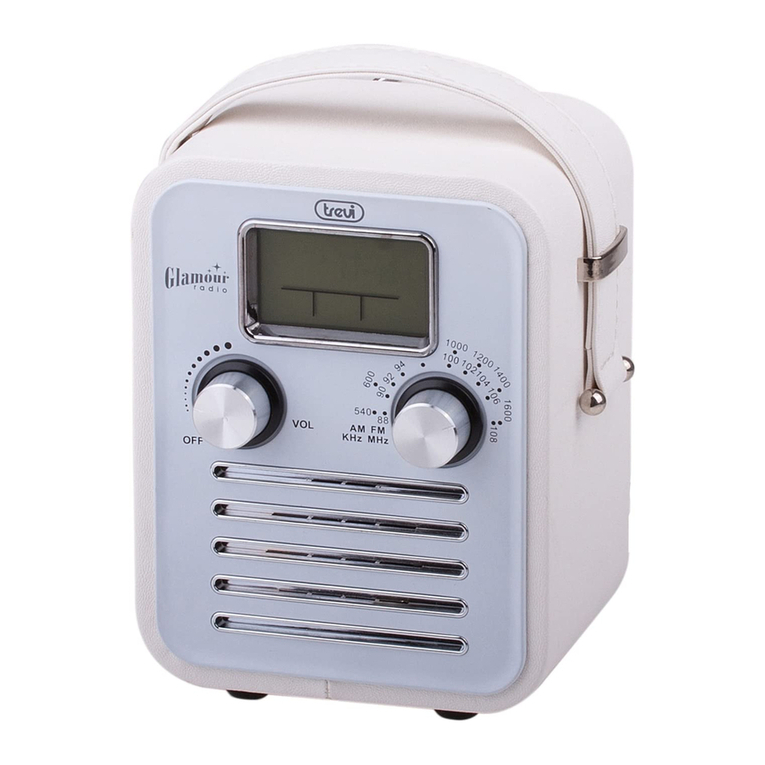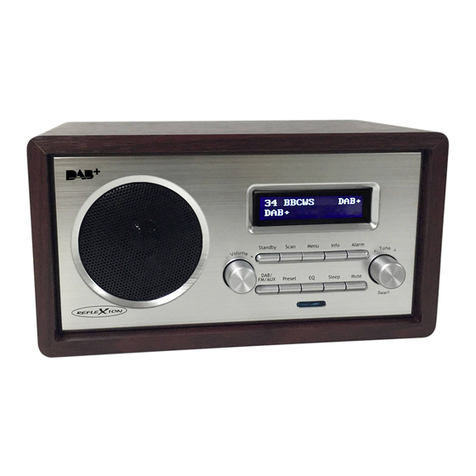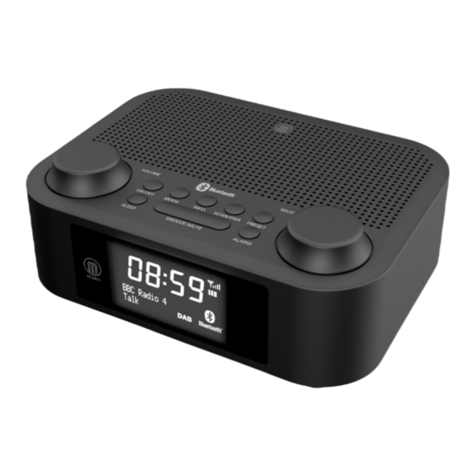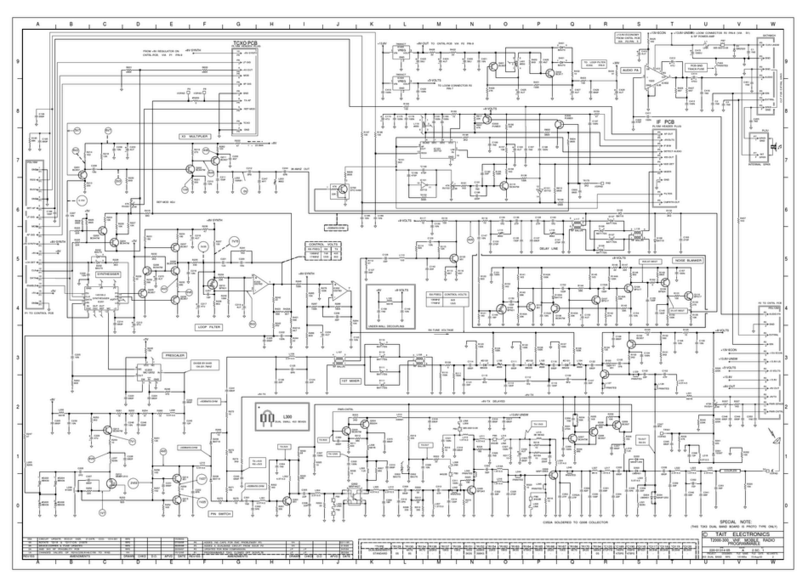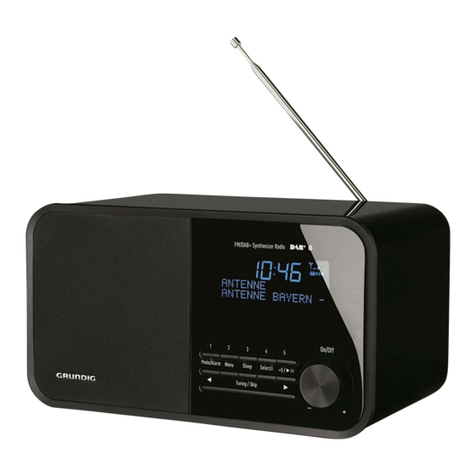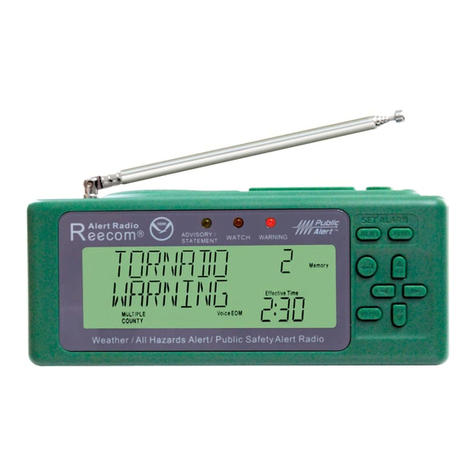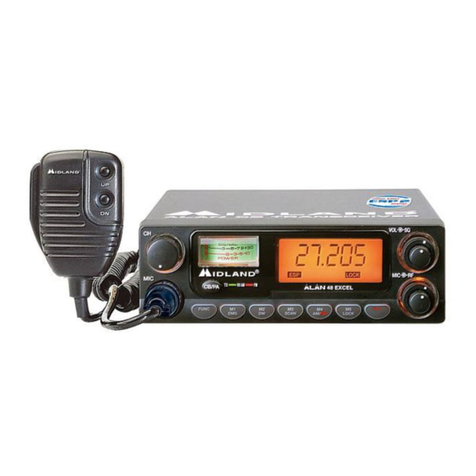ADTRAN TRACER User manual

TRACER®
Easy Steps
to Wireless
Solutions
QUICK REFERENCE GUIDE
WirelessLicense-freeDigitalMicrowaveRadios
4
TRACER Systems
TRACER 2603
■
CompactDual T11UhighBasebandProcessor(BBP)
■
Used in conjunction with TRACER 3000 Series radio
frequency converters (RFC)
■
Major (RF) and Minor (T1) alarms, front panel LEDs
■
TBOS management
■
In-band loopback capability
■
NEBS Level 3 and UL 1950 compliant
■
DC power connector
■
Optional AC adapter 100 VAC to 240 VAC, 50-60 Hz
■
System packages available: packages consist of a
2603 baseband processor, a TRACER 3000 Series
Radio Frequency Converter, and DS-1/DSX-1
interface cables
TRACER 2210/3202
■
Nx64 (N=1 to 24 DS0s) data radio
■
Compact 2210 Data Interface Unit (DIU)
provides a single V.35 interface for
connecting a DTE data device
■
Data rates from 56 Kbps to 1.536 Mbps
■
Mastmount Radio Interface Unit (RIU)
■
22 to 24 AWG twisted pair connection
between DIU and RIU
■
Ideal for LAN-to-LAN bridging, routing,
or videoconferencing
■
Easy to use front panel
configuration
TRACER 2631
■
Wireless T1 and IP router
■
Compact 1U high Baseband Processor (BBP)
■
10BaseT interface for LAN/WAN bridging
and IP routing
■
Independent T1 for voice or additional data
■
Used in conjunction with TRACER 3000 Series
radio frequency converters (RFC)
■
Ideal for LAN-to-LAN connectivity
■
Major(RF)andMinor(T1)alarms,frontpanelLEDs
■
DC power connector
■
Optional AC adapter 100 VAC to 240 VAC, 50-60 Hz
■
System packages available: packages consist of
a 2631 Baseband Processor, a TRACER 3000
Series Radio Frequency Converter, DS-1/DSX-1
interface cable, and a 10BaseT interface cable
TRACER 3000 Series
■
Radio Frequency Converter (RFC)
■
Used in conjunction with TRACER 2600 Series T1
and E1 Baseband Processors
■
Rackmount and mastmount versions available
■
Rackmount versions are 1U high
■
Rackmount configuration ideal for in-building installations
■
Mastmount versions are hermetically sealed
and weatherproofed for outdoor applications
■
2.4 GHz or 5.8 GHz versions available
■
TRACER 3100 - 2.4 GHz rackmount
TRACER 3101 - 2.4 GHz mastmount
TRACER 3200 - 5.8 GHz rackmount
TRACER 3201 - 5.8 GHz mastmount
TRACER 2602/2604
■
Dual E1 (2604) and single E1 (2602) 1U high
baseband processor
■
Used in conjunction with TRACER 3000 Series
Radio Frequency Converters (RFC)
■
License-free in many countries (Contact pre-sales
applications at 800-615-1176 for up-to-date
approval information)
■
Major (RF) and minor (E1) alarms, front-panel LEDs
■
DC power connector
■
Optional AC adapter 100 VAC to 240 VAC, 50-60 Hz
■
System packages available: packages consist of a
2602 or 2604 Baseband Processor and a TRACER
3000 Series Radio Frequency Converter
TRACER 4103/4203
■
Compact 1U high dual T1 microwave radio
■
Economical, integrated BBP, and RFC system
■
Ideal for enterprise point-to-point campus applications
■
Point-to-point up to 30 miles
■
License-free ISM band
■
2.4 GHz (4103) and 5.8 GHz (4203) versions available
■
Direct sequence spread-spectrum technology
■
VT100 management software provides single-entry point
management of remote units on back-to-back networks
■
RF maintenance channel is independent and does not
degrade T1 bandwidth
■
Major (RF) alarm, front panel LEDs
■
DC power connector
■
Optional AC adapter 100 VAC to 240 VAC, 50-60 Hz
Baseband Processors Radio Frequency Converters
Integrated Radio Systems
WirelessLicense-free DigitalMicrowave Radios
ADTRAN’sTRACER®is a license-freewirelessdigitaltransmissionsystem that deliversT1,E1,
or10BaseTinterfaces in point-to-point applications atrangesup to 30 miles.Providingdual
T1/E1at singleT1/E1 pricesmakesTRACERone of the most cost-effective alternatives for
wirelesstransmissiontoday. ADTRAN’sTRACER Series of wirelessproducts offers the industry’s
firstNEBSLevel3compliantspread-spectrumradio.AsauthorizedunderPart15.247oftheFCCrules,
TRACERoperatesinthe2.4to2.4835GHzand5.725to5.850GHzindustrial,scientific,andmedical
(ISM)band.TRACERequipmentcanoperatelicense-freeintheU.S.andmanyothercountries.
Peripheral Equipment
ExpertschooseADTRAN.
™
www.adtran.com
ADTRAN, Inc.
901 Explorer Blvd.
Huntsville, AL 35806
Pre-Sales Support
800.615.1176
www.adtran.com/support
ACES
888.874.ACES
www.adtran.com/support
For More Information
ADTRAN is an ISO 9001 registered company.
ADTRAN is a TL 9000 registered company.
TRACER is a registered trademark of ADTRAN, Inc. ADTRAN is
a trademark of ADTRAN, Inc. All other trademarks and registered
trademarks mentioned in this publication are the property of their
respective owners.
ADTRAN believes the information in this publication to be accurate
as of publication date, and is not responsible for errors. Content
subject to change without notice.
EN386A February 2002
©2002 ADTRAN, Inc. All rights reserved. Printed in the USA.
Antennas
Grid Parabolic
Lightweight and easy to handle. Offers lower wind loading
compared to solid parabolic.
Solid Parabolic
Best performance for 2.4 and 5.8 GHz. May be used with
radome where ice and wind conditions require. All 5.8 GHz
antennas are solid.
Flat Panel
Suitable for many applications, particularly for installations
requiring an antenna that is aesthetically more pleasing than
a parabolic antenna, or when the depth of a parabolic may
prove prohibitive.
Yagi
Inexpensive, limited performance antenna.
Cables
RF Coax
Coaxial cable used to transport radio signals between the
Radio Frequency Converter and the antenna. Signal losses
vary depending on the size and quality of the coax, and the
radio frequency of the transmission.
IF Coax
Coaxial cable used to transport radio signal between the
Baseband Processor and the Radio Frequency Converter.
Because these signals are low in frequency, this cable may
be smaller in diameter, and less efficient than the RF coax.
Type N
A common connector used for radio applications. All TRACER
products, and most antenna, have Type N female connectors
as coaxial connections.
Lightning Arrestor
A protection device placed in the coaxial cable to protect the
radio and other system components from electrical surges
originating from the antenna side.
Waveguide
A device used in lieu of coax for transporting RF signals
between the Radio Frequency Converter and the antenna.
Waveguide is much more expensive and difficult to install
than coax.

TRACER®
Easy Steps
to Wireless
Solutions
QUICK REFERENCE GUIDE
WirelessLicense-freeDigitalMicrowaveRadios
4
TRACER Systems
TRACER 2603
■
CompactDual T11UhighBasebandProcessor(BBP)
■
Used in conjunction with TRACER 3000 Series radio
frequency converters (RFC)
■
Major (RF) and Minor (T1) alarms, front panel LEDs
■
TBOS management
■
In-band loopback capability
■
NEBS Level 3 and UL 1950 compliant
■
DC power connector
■
Optional AC adapter 100 VAC to 240 VAC, 50-60 Hz
■
System packages available: packages consist of a
2603 baseband processor, a TRACER 3000 Series
Radio Frequency Converter, and DS-1/DSX-1
interface cables
TRACER 2210/3202
■
Nx64 (N=1 to 24 DS0s) data radio
■
Compact 2210 Data Interface Unit (DIU)
provides a single V.35 interface for
connecting a DTE data device
■
Data rates from 56 Kbps to 1.536 Mbps
■
Mastmount Radio Interface Unit (RIU)
■
22 to 24 AWG twisted pair connection
between DIU and RIU
■
Ideal for LAN-to-LAN bridging, routing,
or videoconferencing
■
Easy to use front panel
configuration
TRACER 2631
■
Wireless T1 and IP router
■
Compact 1U high Baseband Processor (BBP)
■
10BaseT interface for LAN/WAN bridging
and IP routing
■
Independent T1 for voice or additional data
■
Used in conjunction with TRACER 3000 Series
radio frequency converters (RFC)
■
Ideal for LAN-to-LAN connectivity
■
Major(RF)andMinor(T1)alarms,frontpanelLEDs
■
DC power connector
■
Optional AC adapter 100 VAC to 240 VAC, 50-60 Hz
■
System packages available: packages consist of
a 2631 Baseband Processor, a TRACER 3000
Series Radio Frequency Converter, DS-1/DSX-1
interface cable, and a 10BaseT interface cable
TRACER 3000 Series
■
Radio Frequency Converter (RFC)
■
Used in conjunction with TRACER 2600 Series T1
and E1 Baseband Processors
■
Rackmount and mastmount versions available
■
Rackmount versions are 1U high
■
Rackmount configuration ideal for in-building installations
■
Mastmount versions are hermetically sealed
and weatherproofed for outdoor applications
■
2.4 GHz or 5.8 GHz versions available
■
TRACER 3100 - 2.4 GHz rackmount
TRACER 3101 - 2.4 GHz mastmount
TRACER 3200 - 5.8 GHz rackmount
TRACER 3201 - 5.8 GHz mastmount
TRACER 2602/2604
■
Dual E1 (2604) and single E1 (2602) 1U high
baseband processor
■
Used in conjunction with TRACER 3000 Series
Radio Frequency Converters (RFC)
■
License-free in many countries (Contact pre-sales
applications at 800-615-1176 for up-to-date
approval information)
■
Major (RF) and minor (E1) alarms, front-panel LEDs
■
DC power connector
■
Optional AC adapter 100 VAC to 240 VAC, 50-60 Hz
■
System packages available: packages consist of a
2602 or 2604 Baseband Processor and a TRACER
3000 Series Radio Frequency Converter
TRACER 4103/4203
■
Compact 1U high dual T1 microwave radio
■
Economical, integrated BBP, and RFC system
■
Ideal for enterprise point-to-point campus applications
■
Point-to-point up to 30 miles
■
License-free ISM band
■
2.4 GHz (4103) and 5.8 GHz (4203) versions available
■
Direct sequence spread-spectrum technology
■
VT100 management software provides single-entry point
management of remote units on back-to-back networks
■
RF maintenance channel is independent and does not
degrade T1 bandwidth
■
Major (RF) alarm, front panel LEDs
■
DC power connector
■
Optional AC adapter 100 VAC to 240 VAC, 50-60 Hz
Baseband Processors Radio Frequency Converters
Integrated Radio Systems
WirelessLicense-free DigitalMicrowave Radios
ADTRAN’sTRACER®is a license-freewirelessdigitaltransmissionsystem that deliversT1,E1,
or10BaseTinterfaces in point-to-point applications atrangesup to 30 miles.Providingdual
T1/E1at singleT1/E1 pricesmakesTRACERone of the most cost-effective alternatives for
wirelesstransmissiontoday. ADTRAN’sTRACER Series of wirelessproducts offers the industry’s
firstNEBSLevel3compliantspread-spectrumradio.AsauthorizedunderPart15.247oftheFCCrules,
TRACERoperatesinthe2.4to2.4835GHzand5.725to5.850GHzindustrial,scientific,andmedical
(ISM)band.TRACERequipmentcanoperatelicense-freeintheU.S.andmanyothercountries.
Peripheral Equipment
ExpertschooseADTRAN.
™
www.adtran.com
ADTRAN, Inc.
901 Explorer Blvd.
Huntsville, AL 35806
Pre-Sales Support
800.615.1176
www.adtran.com/support
ACES
888.874.ACES
www.adtran.com/support
For More Information
ADTRAN is an ISO 9001 registered company.
ADTRAN is a TL 9000 registered company.
TRACER is a registered trademark of ADTRAN, Inc. ADTRAN is
a trademark of ADTRAN, Inc. All other trademarks and registered
trademarks mentioned in this publication are the property of their
respective owners.
ADTRAN believes the information in this publication to be accurate
as of publication date, and is not responsible for errors. Content
subject to change without notice.
EN386A February 2002
©2002 ADTRAN, Inc. All rights reserved. Printed in the USA.
Antennas
Grid Parabolic
Lightweight and easy to handle. Offers lower wind loading
compared to solid parabolic.
Solid Parabolic
Best performance for 2.4 and 5.8 GHz. May be used with
radome where ice and wind conditions require. All 5.8 GHz
antennas are solid.
Flat Panel
Suitable for many applications, particularly for installations
requiring an antenna that is aesthetically more pleasing than
a parabolic antenna, or when the depth of a parabolic may
prove prohibitive.
Yagi
Inexpensive, limited performance antenna.
Cables
RF Coax
Coaxial cable used to transport radio signals between the
Radio Frequency Converter and the antenna. Signal losses
vary depending on the size and quality of the coax, and the
radio frequency of the transmission.
IF Coax
Coaxial cable used to transport radio signal between the
Baseband Processor and the Radio Frequency Converter.
Because these signals are low in frequency, this cable may
be smaller in diameter, and less efficient than the RF coax.
Type N
A common connector used for radio applications. All TRACER
products, and most antenna, have Type N female connectors
as coaxial connections.
Lightning Arrestor
A protection device placed in the coaxial cable to protect the
radio and other system components from electrical surges
originating from the antenna side.
Waveguide
A device used in lieu of coax for transporting RF signals
between the Radio Frequency Converter and the antenna.
Waveguide is much more expensive and difficult to install
than coax.

A – Mounting Kit
B – RF Coax
C – RFC Mounting Bracket
D – Lightning Arrestor
E – IF Coax
F – RF Jumper
G –Optional IF Lightning
Arrestor
H – IF Jumper
I – Power
J – Grounding
A
B
C
DE
F
GJ
H
J
I
RJ45
DSX-1
CPE
CPE DSX-1
A – Antenna Mounting
B– RF Coax
C – Lightning Arrestor
D– RF Jumper
E – IF Jumper
F – Power
G– Grounding
A
C
G
B
D
RJ45
DSX-1
CPE
CPE DSX-1
G
F
E
The end user, an ADTRAN Certified Wireless Dealer, or the ADTRAN ACES
organization can perform detailed site surveys for each wireless site. Here are the
key considerations:
Wireless Path
Identify the sites, preferably by latitude and longitude using a map or GPS.
If latitude and longitude are not available, the street addresses may suffice.
TRACER microwave systems require unobstructed Line of Sight (LOS).
❏Can you see the far end, with no obstructions?
❏Is there any possibility of trees that will grow tall enough to interfere?
❏Are there any plans to construct buildings in the path?
❏What is the distance between two sites? Curvature of the earth may affect
paths of more than seven miles
Antenna
The size and style of antenna will be application-dependent. Generally, it is best to
use the smallest antenna that will achieve the desired performance.
How high above the ground can an antenna be installed without using a tower?
Antennas can be mounted on roof, the side of a wall, pole or tower.
❏Does the customer have rooftop or tower permits?
❏For rooftop installations, will there be a need for structural improvements?
❏Are there any additional antennas located at this site?
Site Survey Checklist
Step2
It’ssimple!
Fourstepsensureasuccessfulwirelessinstallation.
A – Mounting Pipe
B – Antenna Braket
C – Wall Mounting
D – RF Coax
E – Lightning Arrestor
F – Grounding
G – RF Jumper
H – Power
A
B
C
D
E
G
H
RJ45
DSX-1
CPE
CPE DSX-1
F
F
ADTRAN®’s wireless products offer a direct alternative to copper-based circuits.
The first consideration is to define connectivity objectives, system requirements,
and cost benefits of the proposed solution.
Wireless solutions can address common scenarios:
Cross community, office park, water, or road – A traditional copper/fiber solution
may require construction (lengthy, and expensive). A wireless solution avoids the
costs and delays.
Provide access to remote locations – Extending landline communications into a
rural or remote location can be cost-prohibitive and time consuming. Wireless
links can be deployed quickly and at a fraction of wireline deployment costs.
Mobile or temporary communications – Special events, emergency communica-
tions, and temporary corporate expansion are ideal for wireless quick deployment.
Cross carrier boundary – Crossing carrier boundaries can be exceptionally
expensive, so a wireless alternative can offer cost-effective solutions.
Economical Alternative – In some locations, a wireless solution achieves a faster
payback and return on investment compared to equivalent landline connectivity.
Step 1 also includes matching the user’s equipment interfaces and bandwidth require-
ments with the appropriate ADTRAN TRACER wireless equipment.
ADTRAN ACES (ADTRAN Custom Extended Services)
For a turnkey job, the ADTRAN ACES group can provide all the necessary planning, site
surveys, equipment and installation, including the construction of a tower, if necessary.
ADTRAN Certified Wireless Dealer
These are wireless application experts that are located regionally throughout the
country. The customer can purchase TRACER and peripheral equipment from these
ADTRAN Partners. ADTRAN Certified Wireless Dealers will also perform all the plan-
ning, site survey, and installation of the wireless system to ensure a successful project.
Customer Installation
If the customer has radio systems expertise, a professional installation staff, and the
time and resources, all ADTRAN equipment and peripherals can be ordered from one
of ADTRAN’s Wireless Distributors or Certified Wireless Dealer partners.
Installation Type
There are three possible ADTRAN system configurations to consider.
These are shown in the example diagrams on the next panel. They
vary depending on the RFC installation.
Installation
Rackmount Mastmount
Options
(Wall, Roof, Pole, Tower)
RFC ❏❏
BBP ❏
TRACER 4000 ❏
This quick reference guide
organizes a TRACER wireless
solution into a step-by-step,
easy-to-follow process outlining
essential considerations for
every phase of your project.
Detailed planning guide:
www.adtran.com/tip
Step 2 Continued
RFC
Maximum system performance is achieved by installing the TRACER
RFC close to the antenna in order to reduce cable and connector losses.
Use the ADTRAN Link Analyzer software tool to calculate antenna size,
cabling, RFC location and overall path performance.
Cables, Power, Grounding, and Lightning Protection
❏Is there adequate equipment room and rack space?
❏How will antenna cabling enter the facility? Penetration
of walls/roofs will require permits and weatherproofing.
❏Ensure that power and grounding systems are available.
❏Plan for lightning arrestors to insulate radio equipment.
❏Define cable lengths.
Identify the Connectivity Application
ADTRAN Systems Configurations
Installation Options
Typical ADTRAN Wireless Systems
4000 Series
Integrated RFC
2600/3000
Mastmount RFC
2600/3000
Rackmount RFC
NOTE: The TRACER 4000
series provides an RFC
and BBP integrated
into a single unit and
is only available in rack-
mount configurations
There is a trade-off to
installing the RFC as
mastmount or rackmount.
Mastmount RFCs can
provide better overall
system performance but
may require climbing if
service is required. Well
designed rackmount
systems can provide
sufficient performance
and easy indoor access.
Step1
Step3
Step4

TRACER®
Easy Steps
to Wireless
Solutions
QUICK REFERENCE GUIDE
WirelessLicense-freeDigitalMicrowaveRadios
4
TRACER Systems
TRACER 2603
■
CompactDual T11UhighBasebandProcessor(BBP)
■
Used in conjunction with TRACER 3000 Series radio
frequency converters (RFC)
■
Major (RF) and Minor (T1) alarms, front panel LEDs
■
TBOS management
■
In-band loopback capability
■
NEBS Level 3 and UL 1950 compliant
■
DC power connector
■
Optional AC adapter 100 VAC to 240 VAC, 50-60 Hz
■
System packages available: packages consist of a
2603 baseband processor, a TRACER 3000 Series
Radio Frequency Converter, and DS-1/DSX-1
interface cables
TRACER 2210/3202
■
Nx64 (N=1 to 24 DS0s) data radio
■
Compact 2210 Data Interface Unit (DIU)
provides a single V.35 interface for
connecting a DTE data device
■
Data rates from 56 Kbps to 1.536 Mbps
■
Mastmount Radio Interface Unit (RIU)
■
22 to 24 AWG twisted pair connection
between DIU and RIU
■
Ideal for LAN-to-LAN bridging, routing,
or videoconferencing
■
Easy to use front panel
configuration
TRACER 2631
■
Wireless T1 and IP router
■
Compact 1U high Baseband Processor (BBP)
■
10BaseT interface for LAN/WAN bridging
and IP routing
■
Independent T1 for voice or additional data
■
Used in conjunction with TRACER 3000 Series
radio frequency converters (RFC)
■
Ideal for LAN-to-LAN connectivity
■
Major(RF)andMinor(T1)alarms,frontpanelLEDs
■
DC power connector
■
Optional AC adapter 100 VAC to 240 VAC, 50-60 Hz
■
System packages available: packages consist of
a 2631 Baseband Processor, a TRACER 3000
Series Radio Frequency Converter, DS-1/DSX-1
interface cable, and a 10BaseT interface cable
TRACER 3000 Series
■
Radio Frequency Converter (RFC)
■
Used in conjunction with TRACER 2600 Series T1
and E1 Baseband Processors
■
Rackmount and mastmount versions available
■
Rackmount versions are 1U high
■
Rackmount configuration ideal for in-building installations
■
Mastmount versions are hermetically sealed
and weatherproofed for outdoor applications
■
2.4 GHz or 5.8 GHz versions available
■
TRACER 3100 - 2.4 GHz rackmount
TRACER 3101 - 2.4 GHz mastmount
TRACER 3200 - 5.8 GHz rackmount
TRACER 3201 - 5.8 GHz mastmount
TRACER 2602/2604
■
Dual E1 (2604) and single E1 (2602) 1U high
baseband processor
■
Used in conjunction with TRACER 3000 Series
Radio Frequency Converters (RFC)
■
License-free in many countries (Contact pre-sales
applications at 800-615-1176 for up-to-date
approval information)
■
Major (RF) and minor (E1) alarms, front-panel LEDs
■
DC power connector
■
Optional AC adapter 100 VAC to 240 VAC, 50-60 Hz
■
System packages available: packages consist of a
2602 or 2604 Baseband Processor and a TRACER
3000 Series Radio Frequency Converter
TRACER 4103/4203
■
Compact 1U high dual T1 microwave radio
■
Economical, integrated BBP, and RFC system
■
Ideal for enterprise point-to-point campus applications
■
Point-to-point up to 30 miles
■
License-free ISM band
■
2.4 GHz (4103) and 5.8 GHz (4203) versions available
■
Direct sequence spread-spectrum technology
■
VT100 management software provides single-entry point
management of remote units on back-to-back networks
■
RF maintenance channel is independent and does not
degrade T1 bandwidth
■
Major (RF) alarm, front panel LEDs
■
DC power connector
■
Optional AC adapter 100 VAC to 240 VAC, 50-60 Hz
Baseband Processors Radio Frequency Converters
Integrated Radio Systems
WirelessLicense-free DigitalMicrowave Radios
ADTRAN’sTRACER®is a license-freewirelessdigitaltransmissionsystem that deliversT1,E1,
or10BaseTinterfaces in point-to-point applications atrangesup to 30 miles.Providingdual
T1/E1at singleT1/E1 pricesmakesTRACERone of the most cost-effective alternatives for
wirelesstransmissiontoday. ADTRAN’sTRACER Series of wirelessproducts offers the industry’s
firstNEBSLevel3compliantspread-spectrumradio.AsauthorizedunderPart15.247oftheFCCrules,
TRACERoperatesinthe2.4to2.4835GHzand5.725to5.850GHzindustrial,scientific,andmedical
(ISM)band.TRACERequipmentcanoperatelicense-freeintheU.S.andmanyothercountries.
Peripheral Equipment
ExpertschooseADTRAN.
™
www.adtran.com
ADTRAN, Inc.
901 Explorer Blvd.
Huntsville, AL 35806
Pre-Sales Support
800.615.1176
www.adtran.com/support
ACES
888.874.ACES
www.adtran.com/support
For More Information
ADTRAN is an ISO 9001 registered company.
ADTRAN is a TL 9000 registered company.
TRACER is a registered trademark of ADTRAN, Inc. ADTRAN is
a trademark of ADTRAN, Inc. All other trademarks and registered
trademarks mentioned in this publication are the property of their
respective owners.
ADTRAN believes the information in this publication to be accurate
as of publication date, and is not responsible for errors. Content
subject to change without notice.
EN386A February 2002
©2002 ADTRAN, Inc. All rights reserved. Printed in the USA.
Antennas
Grid Parabolic
Lightweight and easy to handle. Offers lower wind loading
compared to solid parabolic.
Solid Parabolic
Best performance for 2.4 and 5.8 GHz. May be used with
radome where ice and wind conditions require. All 5.8 GHz
antennas are solid.
Flat Panel
Suitable for many applications, particularly for installations
requiring an antenna that is aesthetically more pleasing than
a parabolic antenna, or when the depth of a parabolic may
prove prohibitive.
Yagi
Inexpensive, limited performance antenna.
Cables
RF Coax
Coaxial cable used to transport radio signals between the
Radio Frequency Converter and the antenna. Signal losses
vary depending on the size and quality of the coax, and the
radio frequency of the transmission.
IF Coax
Coaxial cable used to transport radio signal between the
Baseband Processor and the Radio Frequency Converter.
Because these signals are low in frequency, this cable may
be smaller in diameter, and less efficient than the RF coax.
Type N
A common connector used for radio applications. All TRACER
products, and most antenna, have Type N female connectors
as coaxial connections.
Lightning Arrestor
A protection device placed in the coaxial cable to protect the
radio and other system components from electrical surges
originating from the antenna side.
Waveguide
A device used in lieu of coax for transporting RF signals
between the Radio Frequency Converter and the antenna.
Waveguide is much more expensive and difficult to install
than coax.

A – Mounting Kit
B – RF Coax
C – RFC Mounting Bracket
D – Lightning Arrestor
E – IF Coax
F – RF Jumper
G –Optional IF Lightning
Arrestor
H – IF Jumper
I – Power
J – Grounding
A
B
C
DE
F
GJ
H
J
I
RJ45
DSX-1
CPE
CPE DSX-1
A – Antenna Mounting
B– RF Coax
C – Lightning Arrestor
D– RF Jumper
E – IF Jumper
F – Power
G– Grounding
A
C
G
B
D
RJ45
DSX-1
CPE
CPE DSX-1
G
F
E
The end user, an ADTRAN Certified Wireless Dealer, or the ADTRAN ACES
organization can perform detailed site surveys for each wireless site. Here are the
key considerations:
Wireless Path
Identify the sites, preferably by latitude and longitude using a map or GPS.
If latitude and longitude are not available, the street addresses may suffice.
TRACER microwave systems require unobstructed Line of Sight (LOS).
❏Can you see the far end, with no obstructions?
❏Is there any possibility of trees that will grow tall enough to interfere?
❏Are there any plans to construct buildings in the path?
❏What is the distance between two sites? Curvature of the earth may affect
paths of more than seven miles
Antenna
The size and style of antenna will be application-dependent. Generally, it is best to
use the smallest antenna that will achieve the desired performance.
How high above the ground can an antenna be installed without using a tower?
Antennas can be mounted on roof, the side of a wall, pole or tower.
❏Does the customer have rooftop or tower permits?
❏For rooftop installations, will there be a need for structural improvements?
❏Are there any additional antennas located at this site?
Site Survey Checklist
Step2
It’ssimple!
Fourstepsensureasuccessfulwirelessinstallation.
A – Mounting Pipe
B – Antenna Braket
C – Wall Mounting
D – RF Coax
E – Lightning Arrestor
F – Grounding
G – RF Jumper
H – Power
A
B
C
D
E
G
H
RJ45
DSX-1
CPE
CPE DSX-1
F
F
ADTRAN®’s wireless products offer a direct alternative to copper-based circuits.
The first consideration is to define connectivity objectives, system requirements,
and cost benefits of the proposed solution.
Wireless solutions can address common scenarios:
Cross community, office park, water, or road – A traditional copper/fiber solution
may require construction (lengthy, and expensive). A wireless solution avoids the
costs and delays.
Provide access to remote locations – Extending landline communications into a
rural or remote location can be cost-prohibitive and time consuming. Wireless
links can be deployed quickly and at a fraction of wireline deployment costs.
Mobile or temporary communications – Special events, emergency communica-
tions, and temporary corporate expansion are ideal for wireless quick deployment.
Cross carrier boundary – Crossing carrier boundaries can be exceptionally
expensive, so a wireless alternative can offer cost-effective solutions.
Economical Alternative – In some locations, a wireless solution achieves a faster
payback and return on investment compared to equivalent landline connectivity.
Step 1 also includes matching the user’s equipment interfaces and bandwidth require-
ments with the appropriate ADTRAN TRACER wireless equipment.
ADTRAN ACES (ADTRAN Custom Extended Services)
For a turnkey job, the ADTRAN ACES group can provide all the necessary planning, site
surveys, equipment and installation, including the construction of a tower, if necessary.
ADTRAN Certified Wireless Dealer
These are wireless application experts that are located regionally throughout the
country. The customer can purchase TRACER and peripheral equipment from these
ADTRAN Partners. ADTRAN Certified Wireless Dealers will also perform all the plan-
ning, site survey, and installation of the wireless system to ensure a successful project.
Customer Installation
If the customer has radio systems expertise, a professional installation staff, and the
time and resources, all ADTRAN equipment and peripherals can be ordered from one
of ADTRAN’s Wireless Distributors or Certified Wireless Dealer partners.
Installation Type
There are three possible ADTRAN system configurations to consider.
These are shown in the example diagrams on the next panel. They
vary depending on the RFC installation.
Installation
Rackmount Mastmount
Options
(Wall, Roof, Pole, Tower)
RFC ❏❏
BBP ❏
TRACER 4000 ❏
This quick reference guide
organizes a TRACER wireless
solution into a step-by-step,
easy-to-follow process outlining
essential considerations for
every phase of your project.
Detailed planning guide:
www.adtran.com/tip
Step 2 Continued
RFC
Maximum system performance is achieved by installing the TRACER
RFC close to the antenna in order to reduce cable and connector losses.
Use the ADTRAN Link Analyzer software tool to calculate antenna size,
cabling, RFC location and overall path performance.
Cables, Power, Grounding, and Lightning Protection
❏Is there adequate equipment room and rack space?
❏How will antenna cabling enter the facility? Penetration
of walls/roofs will require permits and weatherproofing.
❏Ensure that power and grounding systems are available.
❏Plan for lightning arrestors to insulate radio equipment.
❏Define cable lengths.
Identify the Connectivity Application
ADTRAN Systems Configurations
Installation Options
Typical ADTRAN Wireless Systems
4000 Series
Integrated RFC
2600/3000
Mastmount RFC
2600/3000
Rackmount RFC
NOTE: The TRACER 4000
series provides an RFC
and BBP integrated
into a single unit and
is only available in rack-
mount configurations
There is a trade-off to
installing the RFC as
mastmount or rackmount.
Mastmount RFCs can
provide better overall
system performance but
may require climbing if
service is required. Well
designed rackmount
systems can provide
sufficient performance
and easy indoor access.
Step1
Step3
Step4
Other manuals for TRACER
1
Table of contents
Other ADTRAN Radio manuals
